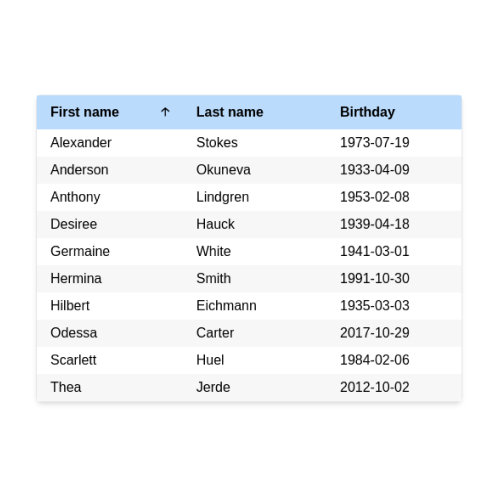Do more with CUSTOM
@Directive()


Adithya Sreyaj
Front-end @ Hypersonix


@Directive()
Directives are classes that add additional behavior to elements in your Angular applications.
- Components - directives with a template.
- Attribute directives - change the appearance or behavior of an element, component, or another directive.
- Structural directives - change the DOM layout by adding and removing DOM elements.

Built-in Directives
- NgClass
- NgStyle
- NgModel
Attribute Directives
- NgIf
- NgFor
- NgSwitch
Structural Directives

Possibilities
- Access to the native element
- Access to template reference
- Listen and Handle events
- Input Validations
Benefits
- Reusable
- Maintainable
- Testable
- Lean Components

Directives in Action


TABLE SORT DIRECTIVE

-
Directive + Component
-
Place the parent directive on the table.
-
Place the sort header directive on the cell header.
-
Complete sorting logic moved outside.
-
Access parent from child directive.

import {
Component, Directive, EventEmitter,
HostListener, Input, Output
} from '@angular/core';
export interface SortChangeEvent {
column: string;
direction: SortDirection;
}
type SortDirection = 'asc' | 'desc' | null;
@Directive({
selector: '[sorter]',
})
export class Sorter {
active: string | null = null;
direction: SortDirection = null;
@Output() sortChange = new EventEmitter<SortChangeEvent>();
sort(column: string) {
let direction = this.direction;
if (this.active !== column) {
this.direction = null;
this.active = column;
}
if (this.direction === null) {
direction = 'asc';
} else if (this.direction === 'asc') {
direction = 'desc';
} else if (this.direction === 'desc') {
direction = null;
}
this.sortChange.emit({
column,
direction,
});
this.direction = direction;
}
}
@Component({
selector: '[sortHeader]',
template: `
<div class="sort-col">
<ng-content></ng-content>
<div
[ngClass]="{
arrow: true,
hide: sorter?.active !== ref || sorter?.direction === null,
asc: sorter?.active === ref && sorter?.direction === 'asc',
desc: sorter?.active === ref && sorter?.direction === 'desc'
}"
>
🡡
</div>
</div>
`,
styles: [
`
.sort-col {
display: flex;
justify-content: space-between;
align-items: center;
}
.arrow {
font-size: 14px;
}
.arrow.hide {
opacity: 0;
}
.arrow.desc {
transform: rotate(180deg);
}
`,
],
})
export class SortHeader {
@Input() ref: string | null = null;
@HostListener('click')
sort() {
if (!this.ref) {
throw new Error('ref should be provided');
}
this.sorter.sort(this.ref);
}
constructor(public sorter: Sorter) {}
}
<table sorter>
<thead>
<tr>
<th ref="firstname" sortHeader>First name</th>
<th ref="lastname" sortHeader>Last name</th>
<th ref="birthday" sortHeader>Birthday</th>
</tr>
</thead>
<tbody>
<tr *ngFor="let user of users$ | async">
<td><div>{{user?.firstname}}</div></td>
<td><div>{{user?.lastname}}</div></td>
<td><div>{{user?.birthday}}</div></td>
</tr>
</tbody>
</table>
Fullscreen Directive


-
Attribute directive
-
Exports the directive to be used in a template
-
Manage state inside the directive
@Directive({
selector: '[appUiFullscreen]',
exportAs: 'fullscreen',
})
export class UiFullscreenDirective {
private isMaximizedSubject = new BehaviorSubject(false);
isMaximized$ = this.isMaximizedSubject.asObservable();
constructor(private el: ElementRef) {}
toggle() {
if (this.isMaximizedSubject?.getValue()) this.minimize();
else this.maximize();
}
maximize() {
if (this.el) {
this.isMaximizedSubject.next(true);
this.nativeElement.classList.add('fullscreen');
if (Fullscreen.isEnabled) {
Fullscreen.request();
}
}
}
minimize() {
if (this.el) {
this.isMaximizedSubject.next(false);
this.nativeElement.classList.remove('fullscreen');
if (Fullscreen.isEnabled) {
Fullscreen.exit();
}
}
}
private get nativeElement() {
return this.el.nativeElement as HTMLElement;
}
}<div appUiFullscreen #fullscreen="fullscreen">
<header>
<p>Total Sales Report</p>
<div>
<button (click)="fullscreen.minimize()">🗕</button>
<button (click)="fullscreen.maximize()">🗖</button>
</div>
</header>
<div class="body"></div>
</div>.fullscreen {
width: 100vw;
height: 100vh;
position: fixed;
top: 0;
left: 0;
}Permission Directive

-
Structural directive
-
Displays content only if authorized
-
Pass feature and permission as input
-
Validates the permission and embed the item in view

@Directive({
selector: '[appUiPermissions]',
})
export class UiPermissionsDirective implements OnInit, OnDestroy {
private loggedInUser!: User;
private permission!: Permissions;
private feature!: string;
private subscription!: Subscription;
@Input()
set appUiPermissions(permission: Permissions) {
this.permission = permission;
this.updateView();
}
@Input()
set appUiPermissionsFeature(feature: string) {
this.feature = feature;
this.updateView();
}
constructor(private tpl: TemplateRef<any>,
private vcr: ViewContainerRef,
private authService: AuthService) {}
ngOnInit() {
this.subscription = this.authService.loggedUser$.subscribe((user) => {
this.loggedInUser = user;
this.updateView();
});
}
ngOnDestroy() {
this.subscription.unsubscribe();
}
private updateView() {
this.vcr.clear();
if (this.hasPermission()) {
this.vcr.createEmbeddedView(this.tpl);
} else {
this.vcr.clear();
}
}
private hasPermission() {
if (!this.loggedInUser) return false;
const featurePermissions = this.loggedInUser.permissions[this.feature];
if (featurePermissions) {
return featurePermissions.includes(this.permission);
}
return false;
}
}
export enum Permissions {
create = 'CREATE',
read = 'READ',
update = 'UPDATE',
delete = 'DELETE',
}
const permissions = {
product: [
'CREATE',
'READ',
'UPDATE'
'DELETE'
]
}<footer>
<button *appUiPermissions="'READ'; feature: 'product'">
View
</button>
<button *appUiPermissions="'UPDATE'; feature: 'product'">
Edit
</button>
<button *appUiPermissions="'DELETE'; feature: 'product'">
Delete
</button>
</footer>BADGES Directive

-
Simple attribute directive
-
Appends a span to the host element
-
Pass options for size and positions

@Directive({
selector: '[badge]',
})
export class UiBadgeDirective implements OnChanges, OnDestroy {
@Input() badge: string | null = null;
@Input() size: BadgeSizes = 'medium';
@Input() position: BadgePositions = 'top-right';
@Input() customBadgeClasses: string | null = null;
@Input() variant: BadgeVariants = 'secondary';
badgeElement: HTMLElement | null = null;
constructor(@Inject(DOCUMENT) private document: Document, private elRef: ElementRef<HTMLElement>) {}
ngOnChanges(changes: SimpleChanges): void {
if ('badge' in changes) {
const value = `${changes.badge.currentValue}`.trim();
if (value?.length > 0) {
this.updateBadgeText(value);
}
}
}
ngOnDestroy() {
if (this.badgeElement) {
this.badgeElement.remove();
}
}
private updateBadgeText(value: string) {
if (!this.badgeElement) {
this.createBadge(value);
} else {
this.badgeElement.textContent = value;
}
}
private createBadge(value: string): HTMLElement {
const badgeElement = this.document.createElement('span');
this.addClasses(badgeElement);
badgeElement.textContent = value;
this.elRef.nativeElement.classList.add('badge-container');
this.elRef.nativeElement.appendChild(badgeElement);
return badgeElement;
}
private addClasses(badgeElement: HTMLElement) {
const [vPos, hPos] = this.position.split('-');
badgeElement.classList.add('badge', vPos, hPos);
if (this.customBadgeClasses) {
const customClasses = this.customBadgeClasses.split(' ');
badgeElement.classList.add(...customClasses);
}
badgeElement.classList.add(this.variant);
badgeElement.classList.add(this.size);
}
}
<button badge="2" position="bottom-left">Test</button>
<button badge="4" position="bottom-right">Test</button>
<button badge="4" size="small">Small</button><button badge="4" size="small" class="btn primary badge-container">
Small
<span class="badge top right secondary small">4</span>
</button>Demo & Code


Resources

- Table Sort Directive: https://bit.ly/3xQvwoK
- Fullscreen Directive: https://bit.ly/3zodydZ
- Badge Directive: https://bit.ly/3oEYZhF
thank you






